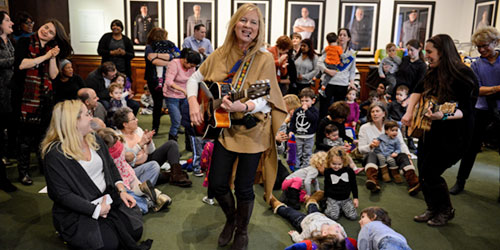92Y Shababa Network: Sharing the Magic
But they were one recent day at 92nd Street Y, learning to give their puppets expression, personality and, most importantly, purpose – as bridges to Jewish experience, learning and spirituality.
“Taking that puppet was a special and powerful moment – awkward at first, but quickly comfortable as it became part of me,” said Lisa Morgenstern-Solomon, an early childhood educator at The Abraham Joshua Heschel School in New York. “The puppet is now an extension of the love I bring to my students and a way to reach them.”
Morgenstern-Solomon was one of about 30 Jewish educators from across the country – rabbis, cantors, program directors, classroom teachers and others – who gathered for a three-day immersion into all things Shababa, the immensely popular Jewish family life and learning initiative founded at 92nd Street Y in 2007.
This annual summit is the centerpiece of the Shababa Network, a community of practice supported by a Covenant Foundation Signature grant, attracting Jewish educators creating or enhancing Jewish family life modeled on Shababa’s overriding philosophy and approach.
That is one combining Jewish tradition with the dynamics of modern Jewish families, allowing them to grow in an environment that is nothing less than artful, celebratory, joyful, creative, and intergenerational.
As if learning the magic of puppetry and its valuable place in the mix wasn’t enough, dissecting the anatomy of a family education program certainly was, as Network members delved into everything from toddler development and family dynamics to effective experiential education as a thread linking generations and creating community.
“Shababa embodies my most deeply held belief in the power of community, the need for connection and the fact that spirited and personal Jewish experiences have tremendous potential for meaning and joy,” said Karina Zilberman, Director of Jewish Family Life and Culture at 92nd Street Y, who created Shababa as a portal for children and their families into Jewish life and education.
While Shababa may be a model of success, Zilberman’s intention is not that Network members create copycat versions in their own communities. This, she said, disregards a community’s particular DNA and singular needs.
Instead, Network members are encouraged to study and emulate Shababa’s driving approach, which emphasizes the “why” of it all, and draw programming from there.
“If we know why we are doing what we are doing, and we believe in it, we will create a community of followers and believers, and not just consumers,” said Zilberman, a 2012 Covenant Award recipient. “If we connect with the why, we are not educators only, or rabbis only, or cantors only. We are enchanters, and that is the Shababa way.”
What started as a pre-Shabbat sing-along – with Zilberman leading just six participants with her guitar and sloth puppet in 92nd Street Y’s lobby – has morphed into weekly events attracting hundreds of children, their families, and others. The celebratory nature of the Shababa experience is buffeted with educational content flowing through in seamless fashion.
Its overwhelming success has positioned it as a paradigm of cross-generational programming and community engagement. Educators across the country have noticed and want to import its approach and spirit into their own institutions, creating the very rationale and success of the Shababa Network itself.
To gauge the hunger, look no further than the Bay Ridge Jewish Center (BRJC) in Brooklyn. When the synagogue’s president, Ruth Masyr, welcomed a new family to the community recently, she was puzzled as to why the mother trekked with her children to 92nd Street Y for Shababa programming instead of partaking in BRJC offerings.
“As soon as I saw Shababa, I knew we needed to offer something as powerful and engaging,” she said. “That is why being part of this network is so important – to get immersed in the philosophy and to figure out what we are doing, how to do it better, and how to connect disparate parts of our membership – the seniors, the families, the children – and create a more spirited place of unity, cohesion and collective learning.”
For Cantor Carol Chesler, who heads Jewish Life and Learning programming at the Sid Jacobson Jewish Community Center on Long Island, the approach resonates as she leads a Tot Shabbat program attracting about 60 children and caregivers every Friday.
“I need to be more mindful about the way I design the whole thing,” she said. “I tend to not think too much beforehand about what it will look like. I rely on my skill to get me through. I’m not thinking about the bigger picture – the why, the goal.
“It’s much more than singing about dinosaurs. It has to be a way of creating sacred space and sacred time and having children and families experience something that is quite transformative.”
Besides the annual summit bringing practitioners together for intense professional development and study, the Shababa Network allows educators to stay connected and share strategies and tactics through a regular series of webinars, an active social media community, open-sourced toolkits and frequent consultations.
A desired result, Zilberman said, is the creation of Shababa-inspired experiences that, while informed by 92nd Street Y’s approach, talks to the communities in which they exist. Networked organizations will be positioned to serve as mentors to others as well.
“Shababa is an organic notion, not a prescriptive one,” she said. “The cohort of educators themselves in this ever-expanding network are at the forefront of what will be a sustainable community. It will evolve to be global and decentralized.”
Anyone who has ever been to a Shababa event at 92nd Street Y knows Coco, Zilberman’s sloth puppet that is a magical point of connection between her and multi-generational Shababa participants. Coco has become, in a sense, a mascot and symbol of the program.
That is why Network participants were equipped and trained with their own sloth puppets to integrate into programming at home – not only to have a living symbol of the Shababa approach, but a real tool to eliminate barriers and create openings for a new type of engagement.
Rabbi Dina Rosenberg of Bay Ridge Jewish Center said she planned to first use hers at an event unaccustomed to puppetry – an upcoming meeting of the synagogue board of directors.
“It will be a good way to get our board going with our new Shababa-inspired approach at our synagogue,” she said. “We don’t want to be creating programs anymore. We want to be creating experiences and relationships. That’s the Shababa way, and that’s our future.”
By H. Glenn Rosenkrantz, for The Covenant Foundation



